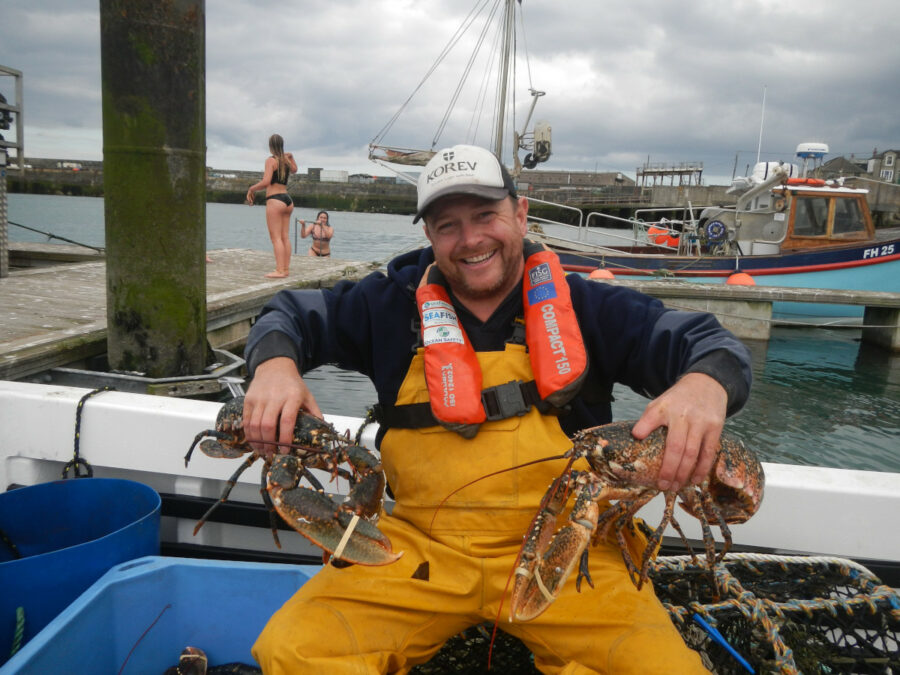As Cornish skipper Daniel Gilbert takes delivery of the 6.4m Girl Dee Dee, the Buccaneer B19 and B21 still lead the field in GRP boat design, reports Phil Lockley
While the designs of U10 rule-beaters are racing ahead, it might seem that the design of displacement craft of between five and seven metres LOA is not.
Few such boats are made of steel, few if any new builds in wood are underway, and the financial risk of building a mould to make a new design in GRP is considerable.
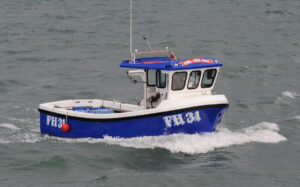
Girl Dee Dee FH 31 on sea trials. Designed over 25 years ago by Gary Mitchell, the Buccaneer B21 is still a tall order to challenge.
Yet among today’s GRP favourites are those released two decades ago from Buccaneer Boats Ltd, which may still be ahead of their time. Delivered in September 2000, the first such boat was a Buccaneer B19, Golden Sceptre, built in Cornwall for Isle of Man skipper Neil Watterson.
The Buccaneer B19 and B21 still present a considerable challenge to any designer wishing to equal or better their success. A few designers tried to catch up, but Buccaneer Boats held the majority of that market. It’s fair to say it stayed in the lead.
The mould was made by Paul Draper and his workforce, including the young GRP boatbuilder Patrick Kemp, now the boss at Pk Composites, which specialises in the building of B19s and B21s. The firm recently delivered the latest B21, Girl Dee Dee FH 31, to Cornish skipper Daniel Gilbert.
He wanted a 21ft boat big enough to tackle several inshore fisheries – a boat with plenty of beam and depth, but having sufficient bilge keels to safely dry out at a tidal port without leaning over too far. Similar Buccaneer boats work from the nearby port of Cadgwith Cove, and that style became a template upon which the fit-out of Girl Dee Dee is based.
Daniel Gilbert’s other work in the offshore oil and gas industry enabled him to take time to decide exactly what he wanted from his ideal boat. Girl Dee Dee is well able to work from either a cove or from all-tide ports such as Newlyn.
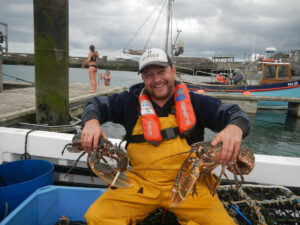
Skipper Daniel Gilbert will mainly target lobsters, using single pots rather than strings.
He said: “I’m not sure yet where to work from, but in all likelihood some of the year it will be from the harbour of Newlyn, and other parts of the year closer to home from the tidal harbour at Porthleven. On coming aground, the boat will not heel over so much that any gear on deck may slide or tip over. My offshore work means that I often get called back with little warning. I have to know that the boat is safe while I am away, and having extended bilge keels similar to the Buccaneer boats at Cadgwith Cove provides that safety.
“Also, on Girl Dee Dee the extended bilge keels contain a considerable portion of the boat’s ballast, bringing the centre of gravity down even further than with traditional ballast, and that can only be good.
“I wanted a boat for my main fishery of potting, but one able to cover other fisheries – a true multi-purpose boat – and that’s what I have. I cannot praise the workmanship from Pk Composites enough. They have built exactly the boat I wanted, and with Patrick Kemp having been there since the birth of Buccaneer Boats over 20 years ago, his experience is second to none.
“The types of fishing I wish to explore are sustainable fisheries like my present one, using single pots rather than strings, mainly for lobster. I wanted a pot hauler to make the lifting of heavy ‘singles’ easier. I went to Spencer Carter, saw Richard Carter, and discussed exactly the hauler I wanted – a P-bracket hauler. Including a top block was suggested so that heavy single pots are raised above the gunwale height and can safely be swung in. I don’t want to end up having to heave the pots onto the gunwale – that’s unnecessary back-breaking work.
“All through this build, I have gone to the experts and taken advice before making a decision. That applies to the engine. There are many to choose from, and most are very good.
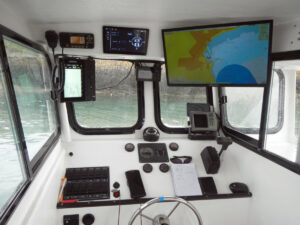
The spacious wheelhouse has an impressive array of electronic gear, all supplied by Comfish Marine.
“Asking around, I heard from so many skippers that Volvo Penta is very reliable. I didn’t hear one bad comment about a Volvo, and went to Marine Engineering (Looe) Ltd, which advised that a D2 was suitable.
“For the stern gear and propeller, I sought expert advice from C&O Engineering at Newton Abbot. I was advised that having a 20in-diameter four-bladed propeller was the best option, because on the Girl Dee Dee there is the advantage of having the ‘bubble’ – a recess in the upper hull – allowing propellers of a larger diameter to be swung. I think this is the first B21 to be fitted with the ‘bubble’.”
If the Girl Dee Dee is used as a typical beach boat, for launch and retrieve the strengthening bar from the keel iron to the outer transom will give further ruggedness. The keel iron is made of galvanised steel.
Although they are at present unnecessary, the hull of Girl Dee Dee has ‘steps’ fitted at the bow (and one amidships) to provide easier boarding from a beach or cove on launch or retrieve.
Although Daniel Gilbert had a transom door included in the build, this will not be needed initially. He explained: “While with single pots I don’t need a pot door, if I want to diversify in the future, I won’t need a costly refit to have one installed. And although I have no intention of selling the boat, should I wish to at a later date, added facilities like that are attractive. The same applies to having the extended bilge keels and boarding footholds.
“The wheelhouse is custom-built, and is larger than normally seen on a B21. By using just single pots, I can afford to sacrifice deck space, and having more comfort in the wheelhouse is important because steaming between Falmouth or further around the Lizard, to places like Newlyn, takes quite a bit of time, and in poor weather, a small wheelhouse would mean several hours of discomfort. I’ve had the wheelhouse width made sufficient to sit two people.”
Cornish firm Comfish Marine, based at Newquay, supplied a large package of gear to the Girl Dee Dee, including the electronics: a Simrad S2009 dual-frequency echosounder, a Furuno GP39 GPS, an Icom VHF DSC, a VHF antenna and a Raymarine AIS. Electrical wiring on the Girl Dee Dee was also carried out by Comfish Marine.
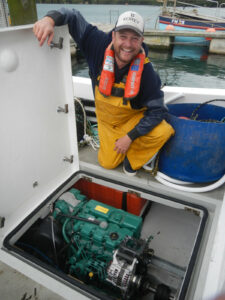
Daniel Gilbert is delighted with the new Volvo Penta engine. It is so quiet, he says, that he has to check the gauges to know whether it is switched on!
Head of Comfish Marine, Newquay skipper Ben Eglinton, explained: “We supplied all the seacocks, strainers, deck-wash pumps and switch panels, and all the marine-grade cabling. Electronics is a new sector of Comfish Marine, and something we are developing. We are normally associated with supplying fishing gear, but from the start of Comfish Marine, I had plans to encompass a much bigger aspect of the fishing industry, and it is working well. More skippers are asking for quotes from us on electronic gear or electrical installation, and we are competitive.
“We also supplied a considerable package of fishing gear that Daniel wanted. He already has single pots from a few firms including Caithness Creels. We have supplied new pots manufactured by Mustang Engineering, ropes and other items.”
The boat will soon be fitted with an aft gantry and rails, made of marine-grade alloy, after which – depending on whether Daniel Gilbert is called overseas – shakedown of the Girl Dee Dee will take place.
It’s the sort of boat that many would put on their wish-list, and the sail-away price isn’t out of reach. Daniel has back-up from his other job, but nevertheless, ‘every penny had to be counted’, he said.
The workmanship on the Girl Dee Dee is superb, but you wouldn’t expect less – Patrick Kemp has been a builder of Buccaneer Boats since his apprenticeship. That’s not to say he only builds Buccaneers – Pk Composites will build whatever GRP boat a skipper wants. But he sees a bright future for B19s and B21s, hoping – like everyone else – that after Brexit we will see inshore fishing grounds out to 12 miles secured solely for UK boats.
Buccaneer boats: ahead of their time
Boats between 5m and 8m LOA are an important sector of the British inshore fleet, and there are few UK ports where a Buccaneer boat of that range is not currently (or was not recently) based. With forthcoming post-Brexit changes, the small-boat fleet may once again be a sector in which to invest.
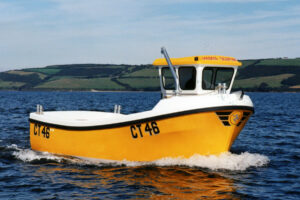
First from the B19 mould, the Golden Sceptre began its work with Manx skipper Neil Watterson.
Designed by Gary Mitchell from Portmellon in Cornwall, the series began as the B19 (5.92m LOA). Later, the B19 mould was adapted to produce the B21. Some B21s were stretched even further, several to 23ft and one to 25ft – the Kingfisher FH 529 of Cadgwith Cove.
Used mainly for static gear, the scope of a B19/B21 was extended by the recent introduction of a Spencer Carter small single-drum winch made in stainless steel.
In relatively shallow water, a B19 or B21 may have the option to tow a small trawl, or even a couple of scallop dredges. Forty years ago in Cornwall, a small seasonal inshore fishery for prawns and/or shrimps took place, in which several small boats, each using a mini beam trawl, did very well.
Judging a Buccaneer B19 against a traditional Cygnus Marine GM19 (also designed by Gary Mitchell) compares two completely different designs aimed at distinct markets; they are boats with a different price tag. However, such a comparison is not a step back in time. Both have a place in today’s inshore fishing industry, but in simple terms you could place a GM19 hull (like mine) into a Buccaneer B19 hull and have plenty of space remaining.
Designed as a flush-deck boat, a B19 provides far greater deck space than any open-deck contender. Having a ‘fuller’ hull, greater beam width and more depth increases the amount of fishing gear and/or catch that can safely be carried.
In my opinion, saying that the evolution of small GRP boats is out of step with that of the current U10 rule-beaters is not a fair assessment.
Compare a 9.9m vessel of 30 years ago to one of today and the difference is striking. That difference may look similar to the GM19 lying alongside a Buccaneer B19 – but that jump in design took place 20 years ago!
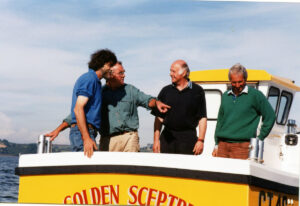
After the sea trials of the first Buccaneer B19 in 2000, designer Gary Mitchell (second from left) seems pleased with what was to become one of the fastest-selling GRP boats of that size.
Designer Gary Mitchell explained: “Around mid-1999, I was approached by a Mevagissey fisherman who wanted a ‘big’ small boat. He was the instigator of designing the B19.
“He grew up seeing wooden ‘toshers’ of that size worked from ports like Mevagissey. I had designed the Cygnus Marine GM19 and GM21 many years before, but he wanted a boat far bigger in fishing terms – but it had to have the same LOA. He also wanted it to have a bulbous bow, and thought that a good name for the design would be ‘Longshoreman’ – a term often used in the history of inshore fishing in Cornwall. But in the end, it became the Buccaneer B19. He wanted a really chunky, full-bodied little boat – which it is.
“I didn’t draw those lines by computer; it was done in a traditional manner on a drawing board. For most designers of fishing boats, that technology wasn’t then available. I am told that the Buccaneer B19 design was well ahead of its time – miles ahead – and I’m pleased to hear such comments.”
I can remember watching Gary work on the Buccaneer B19 lines, and can confirm that there were no high-tech computer aids at work. True marine architecture took place, and luckily, of the leading designers we have in the fishing industry, not one is wholly dependent upon a computer – long may that last!
Looking through my old albums, there are so many pictures of Buccaneer B19s and B21s – even a couple of B23s, and that one B25 at Cadgwith Cove.
Here’s a sample of those pictures, from the first, the Golden Sceptre, and through the steady stream of builds that followed, which saw Buccaneers dispatched far and wide around the UK.
Buccaneer Boats also sold hulls or part-builds to other yards like H Baumbach & Sons. During the early to mid 2000s, new Buccaneer boats were being launched week after week – sometimes two at once, like the day that sea trials took place for the Shamrock, for Falmouth, and the Erin J, destined for the east coast.
You can see more Buccaneer pictures on my Facebook page, plus a short video I took during sea trials of the Golden Sceptre.

